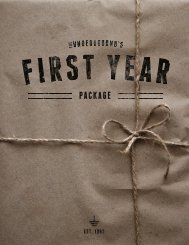Issue 03
You also want an ePaper? Increase the reach of your titles
YUMPU automatically turns print PDFs into web optimized ePapers that Google loves.
12<br />
ARTS & LIFE<br />
you draw your inspiration from?<br />
AS: There’s a performance artist named Ana<br />
Mandieta, I like a lot of her works but she really<br />
incorporates her body into the way her<br />
pieces are read. Many of them have these<br />
intersections of her body and landscape or<br />
her body and different materials and the<br />
ways that she can use her body to convey<br />
something to a viewer. It’s really personal<br />
but it’s also very moving and vulnerable.<br />
For Deface I was interested in the<br />
idea of the psychodynamics of subjects and<br />
objects, the ways that we read bodies, situate<br />
them and visualize them. One of the<br />
pieces was kind of paying homage to her.<br />
Liminal was an outline I did on a sheet and<br />
then I had my partner trace my body with<br />
red paint and stitched that outline of a body<br />
onto another bedsheet. I thought it was very<br />
vulnerable but personal because these are<br />
domestic objects that experience so much<br />
of us in the ways that we use them. It was<br />
kind of playing on this idea of a body that is<br />
marked itself on an object but it’s not there;<br />
this idea of absence and presence. I think<br />
underlying a lot of this was ideas of uncanniness<br />
and death drives. When you see the<br />
outline you think someone killed themselves<br />
or [you think of] the way police investigations<br />
work. I thought a lot about her and then<br />
expressionist painters and the ways they’re<br />
using colour cause I wanted colour to be a<br />
big element in this.<br />
UG: How did the themes you explore disrupt<br />
space?<br />
AS: There were parts of the exhibit that I<br />
could tell was not foreseen by a lot of the<br />
people organizing it and was also something<br />
that, I guess, you wouldn’t expect from a<br />
student-run gallery or from a student. One of<br />
the pieces that I’m referring to was _______<br />
(read: blank): the journal entry and the bed<br />
sheet came from an event that I was experiencing.<br />
I went through an abusive event<br />
and the only way I could forget and remember<br />
it was to write it. My safety counsellor<br />
told me to start writing things down and I<br />
didn’t want to because when you go through<br />
trauma, well at least for me, I kind of get<br />
very mechanical and close up. I don’t always<br />
feel the need to translate what is happening<br />
mentally outside of myself, to externalize it.<br />
I had to explain the text that was<br />
written because it’s not clear at first until you<br />
get to the end and I guess you can sort of<br />
piece it together. I had to explain that to my<br />
teacher and people who where they cause<br />
they thought it was a narrative of about the<br />
mannequin. No, this is actually my experience<br />
of being defaced and being stripped<br />
of my agency and my ability to be, live and<br />
thrive in a healthy manner. Also, just the<br />
idea of what we think of performance artists<br />
as like white people who do all this weird<br />
shit and no one understands it. To bring your<br />
identity into that and into these spaces that<br />
are obviously dominated by whiteness was<br />
something that felt a bit disruptive and vulnerable.<br />
I’m not sure how it was received<br />
by everyone. It was the idea of—and this is<br />
something that gets spoken about in art and<br />
in unhealthy and healthy ways in Muslim<br />
communities— it’s like you’re allowed a certain<br />
amount of agency as a woman but once<br />
you start crossing boundaries and really expressing<br />
yourself the way you want to, then<br />
it’s not okay. How do we speak about these<br />
ideas and these conversations? That’s also<br />
something that was worrying me. You can<br />
own your identity to an extent but once it<br />
gets too personal, you start worrying about<br />
who’s reading this, who’s gonna talk about<br />
this...so there was that element.<br />
The idea that displaying Muslim<br />
identity onto walls and very explicit, bare<br />
and present, that felt a bit disruptive. I think<br />
a lot of people were pleased with it cause<br />
you don’t really assume that you will start<br />
mattering enough to be located in these<br />
spaces, I think that intrigued people...I was<br />
thinking a lot about like how do we combine<br />
my ideas of monstrosity, ugliness, pain,<br />
hurt and catharsis and embed it into photograph?...It<br />
just felt more empowering to<br />
have these unconventional portrayals.<br />
UG: What did you intend the takeaway<br />
be for gallery attendees?<br />
AS: I’m a very private person but this exhibit<br />
almost felt very open to me in some<br />
sense. I didn’t want to make art that was<br />
very detached from who I am so I just<br />
wanted that element in there. I have a diary<br />
entry written on a sheet and that was<br />
something that is directly connected to me<br />
as opposed to these other things more abstract<br />
in nature.<br />
Just the idea that of thinking about<br />
bodies and thinking about spectacle and visual<br />
economies, the way they read bodies,<br />
faces and things that make us feel uncomfortable.<br />
There were mannequins and they<br />
really freaked people out. One of the mannequins<br />
were also bandaged so there’s this<br />
idea of [wondering], ‘Is this supposed to be<br />
human?’. It’s not and that’s why it’s making<br />
us very uncomfortable and we can’t see<br />
them, which is also playing on this discomfort;<br />
the idea of this unreciprocated looking<br />
and trying to figure out what is underneath<br />
these things.<br />
You get those comments a lot<br />
where you look people who wear the hijab<br />
or burqa, people come up to them and say,<br />
‘I want to see your face’, ‘Do you have hair<br />
underneath?’. There’s always this idea of<br />
wanting to strip and wanting to bare things<br />
to see them. No one realizes how politically<br />
embedded that can be. This idea of<br />
stripping layers is also an analogy towards<br />
understanding who you are as well. The<br />
idea of unravelling someone to find out who<br />
they are, getting to know them at their bare<br />
bones. I think that’s something that drives a<br />
lot of us towards ourselves and others.<br />
www. the-underground.ca NOVEMBER 3 - NOVEMBER 30, 2016<br />
VOLUME 36, ISSUE <strong>03</strong>


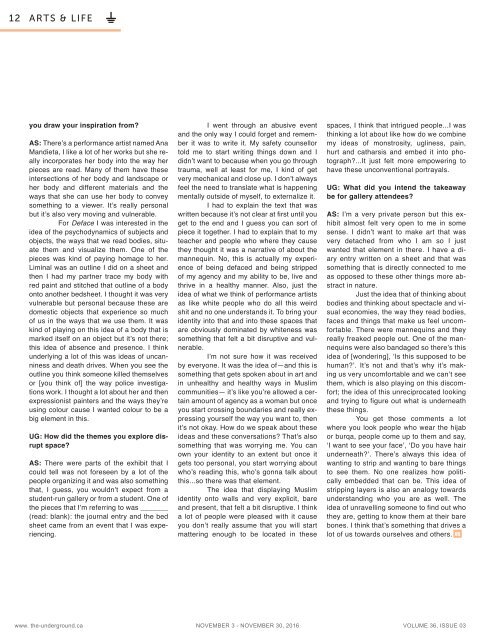

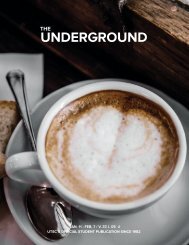
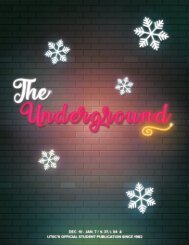
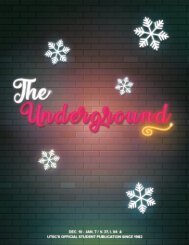
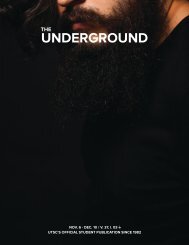
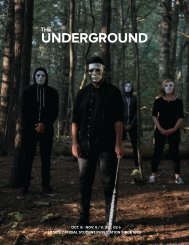

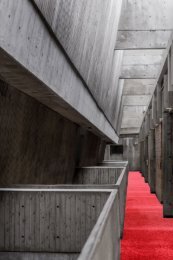
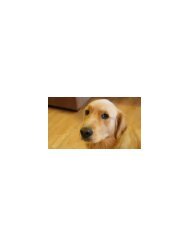
![[WEB]_ISSUE 06[EDIT3]_RachelChin](https://img.yumpu.com/58105406/1/190x245/web-issue-06edit3-rachelchin.jpg?quality=85)

